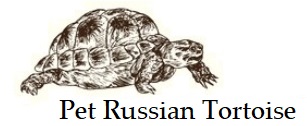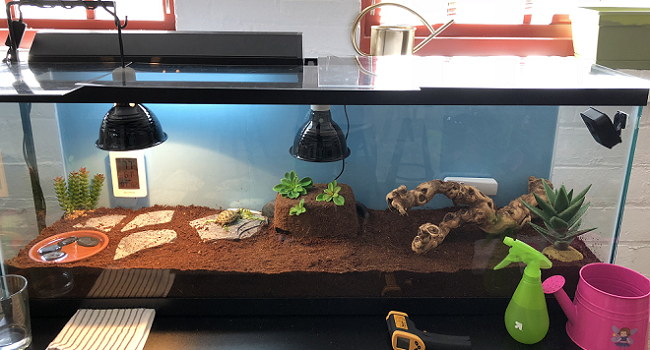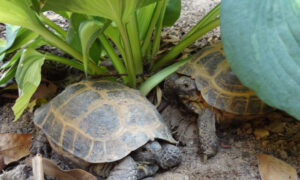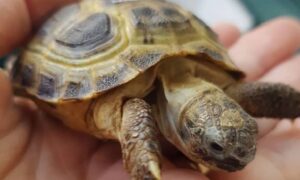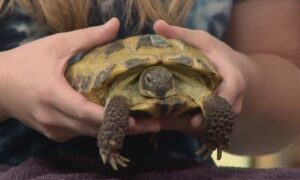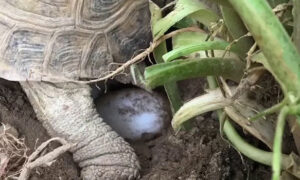Baby Russian tortoises require similar care as adult Russian tortoises. They have similar needs and requirements. The main difference for caring for a baby Russian tortoise is that babies need higher humidity to keep hydrated and ensure healthy growth. A dry environment can cause irregular growth patterns and possibly pyramiding.
When a baby Russian tortoise is close to 4″ long, or at least 2 – 3 years old, you can transition to standard Russian tortoise care with an average humidity of 30% – 50%.
Humidity for Baby Russian Tortoise
For hatchling and yearling Russian tortoises, you want to the humidity to be about 50% – 70%.
Use a digital humidity gauge to read the humidity levels in the enclosure. You do not want the enclosure set for tropical with moisture dripping down the walls, but you want the enclosure to be humid.
Set up a reptile fogger. Plug the fogger into a timer, setting it to come on when the lights come on. It will help simulate morning fog. You typically won’t need the fogger running all day, as this can create more of a tropical enclosure with the high temperatures required for Russian tortoises.
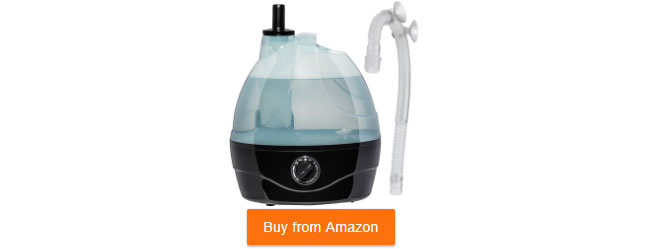
You want the enclosure humid and moist, but not soaking wet. If you can squeeze the substrate and a drop or two of water seeps out, you’re probably fine. If a stream comes out, the enclosure is too wet.
How to Achieve Humidity for Baby Russian Tortoise
The easiest way to achieve proper humidity levels for a baby Russian tortoise is to set up a closed chamber.
A true closed chamber for a baby tortoise will have the lights on the inside of the enclosure. The enclosure is essentially fully closed in. This traps the humidity and heat inside the habitat.
Mist the tortoise daily and ensure the water bowl is filled with fresh water.
Set Up An Indoor Enclosure for a Baby Russian Tortoise
When you get your baby tortoise, have the habitat ready to go. Run through the lighting, heating and humidity to make sure that your timers are running properly and the setting are dialed in.
Use a minimum of a 40-gallon breeder tank or a 50-gallon tote for a baby Russian tortoise. This will provide ample space and room to grow.
Set up a UV light source and heat source. Stick with a basking site of about 95°F with an ambient temperature no lower than 70°F.
Use a safe bedding, like coco coir (Eco Earth). Eco Earth by Exo Terra is great for digging, as well as holding moisture. As the baby tortoise grows, you can change the substrate to a mulch, which is easy to clean and safe for tortoises.
Baby Russian Tortoise Diet
Like an adult Russian tortoise, baby tortoises require a high fiber diet. Stick with high fiber weeds and greens.
Weeds
- Broad leaf plantain
- Cats ear
- Chickweed
- Chicory
- Clovers
- Creeping thistle
- Dandelion
- Deadnettle
- Lamb’s lettuce (corn salad)
- Mallow
- Narrow leaf plantain
- Nettle
- Prickly sow thistle
- Ragweed
- Small sow thistle
- Spear thistle
- White deadnettle
Greens
- Arugula
- Boston lettuce
- Butter lettuce
- Chicory
- Dandelion greens
- Endive
- Escarole
- Grape leaf
- Green oak leaf
- Oak leaf
- Radicchio
- Red leaf lettuce
- Romaine
- Spring Mix lettuces
